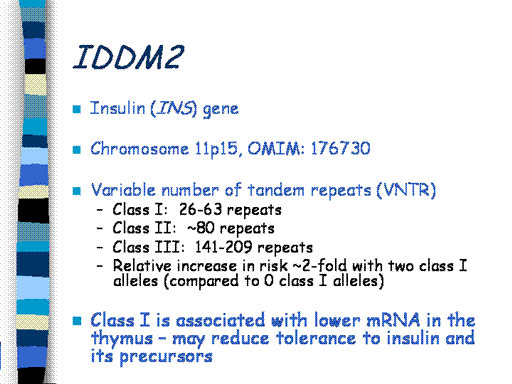| front |1 |2 |3 |4 |5 |6 |7 |8 |9 |10 |11 |12 |13 |14 |15 |16 |17 |18 |19 |20 |21 |22 |23 |24 |25 |26 |27 |28 |29 |30 |31 |32 |33 |34 |35 |36 |37 |38 |39 |40 |41 |42 |43 |44 |45 |46 |47 |48 |49 |50 |51 |52 |53 |54 |review |
 |
The next
strongest locus involved in genetic susceptibility to T1D is IDDM2
on the short arm of chromosome 11.
This locus encodes the insulin gene (INS).
Additional information about the insulin gene (and other genes)
can be found by searching the OMIM database (Online Mendelian
Inheritance in Man) on the National Center for Biotechnology Information
web site (www.ncbi.nlm.nih.gov).
The OMIM number for the insulin gene is 176730.
The 5’
regulatory region of INS contains a variable number of tandem repeat
(VNTR) locus that has been associated with T1D.
There are 3 classes of VNTR alleles: class I (26-63 repeats),
class II (~80 repeats), and class III (141-209 repeats).
The next slide illustrates the location of the VNTR.
A person who carries two class I alleles has about a two-fold
increase risk of developing T1D compared to those who carry no class I
VNTRs. Class III alleles seem to
provide dominant protection against developing T1D.
Class II alleles are virtually non-existent in Caucasian
populations and have no effect on T1D risk.
The insulin
locus and the other candidate regions identified by genome screens
require further evaluation studies before they can be used for genetic
screening for T1D.
|